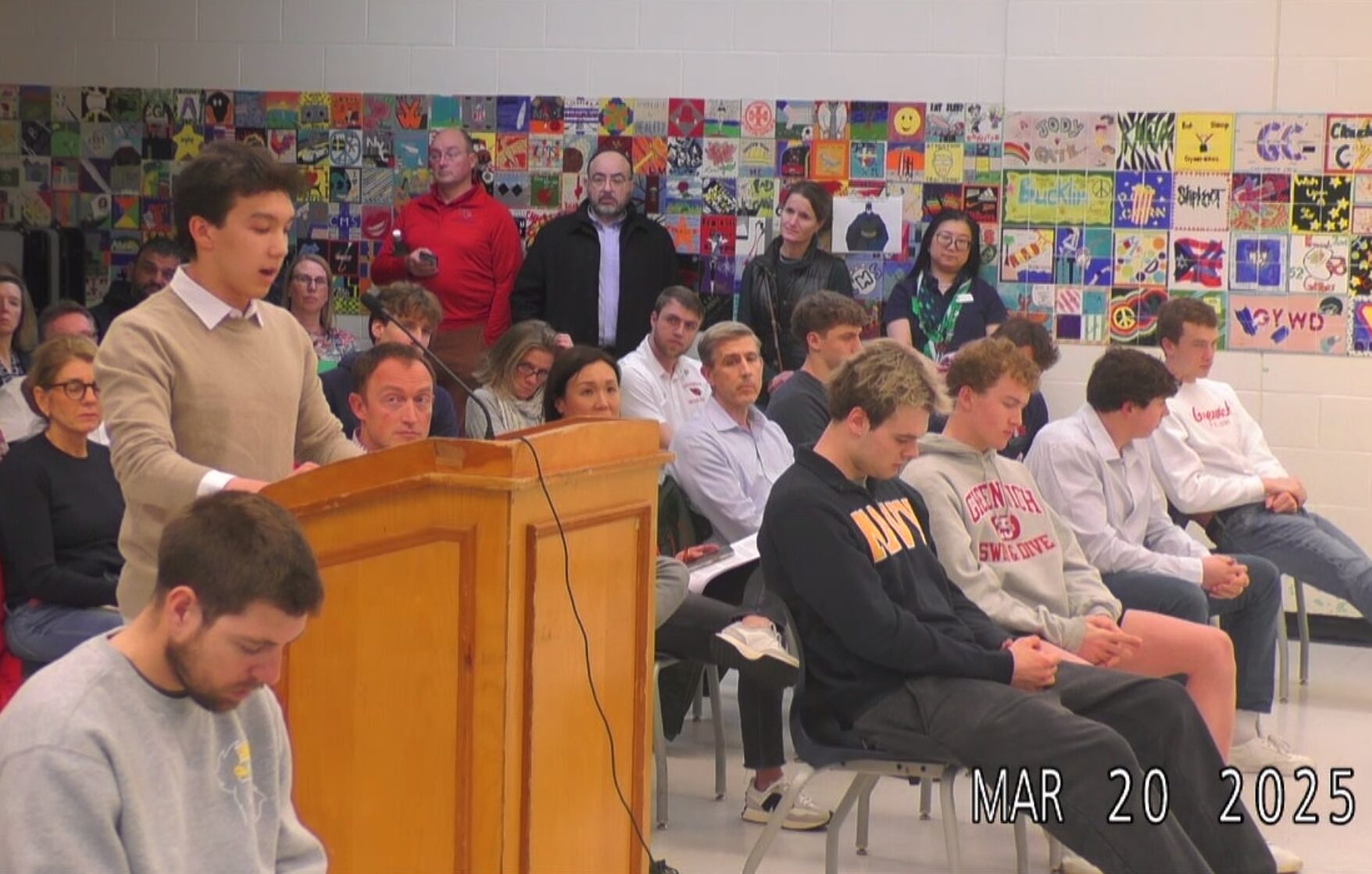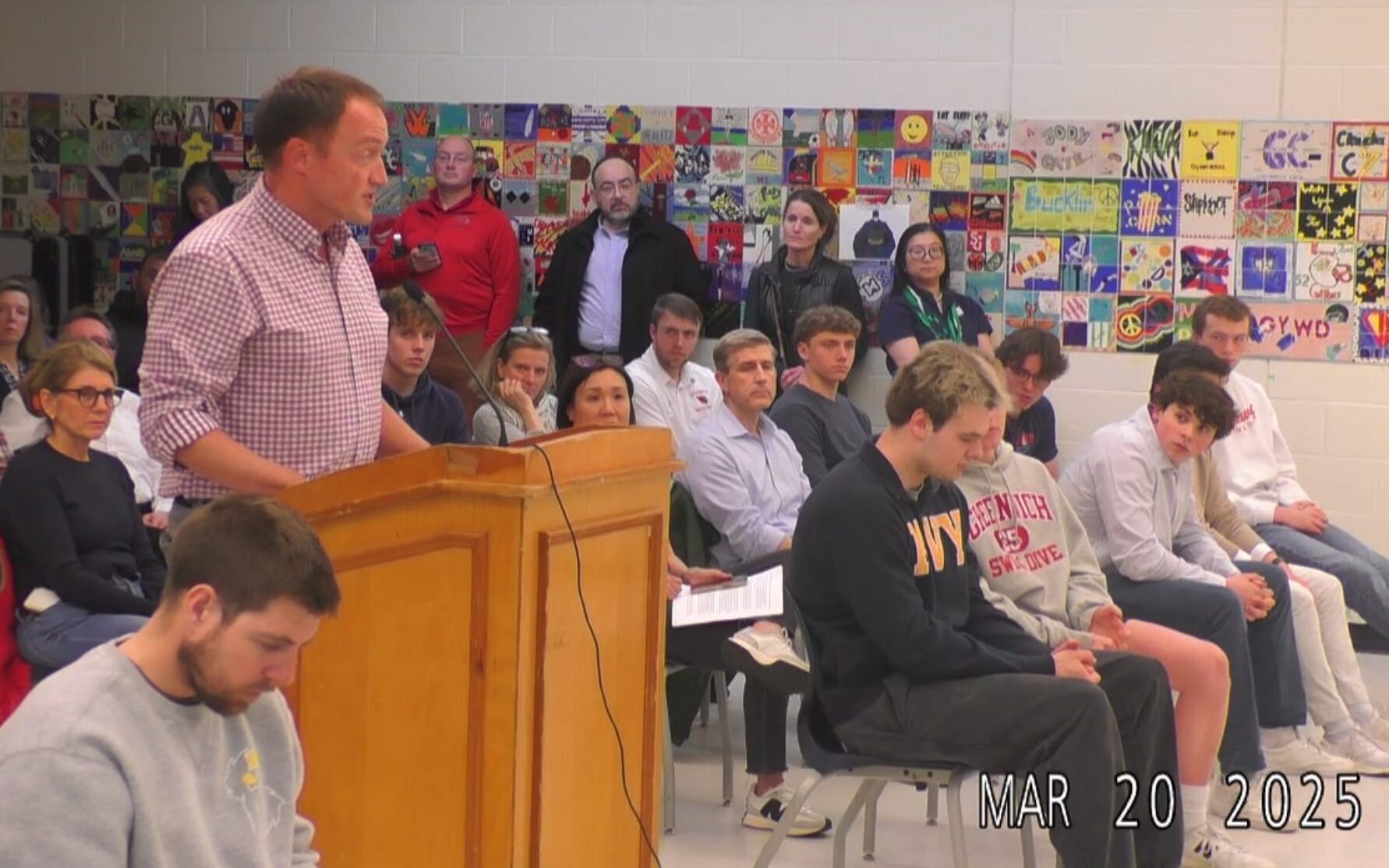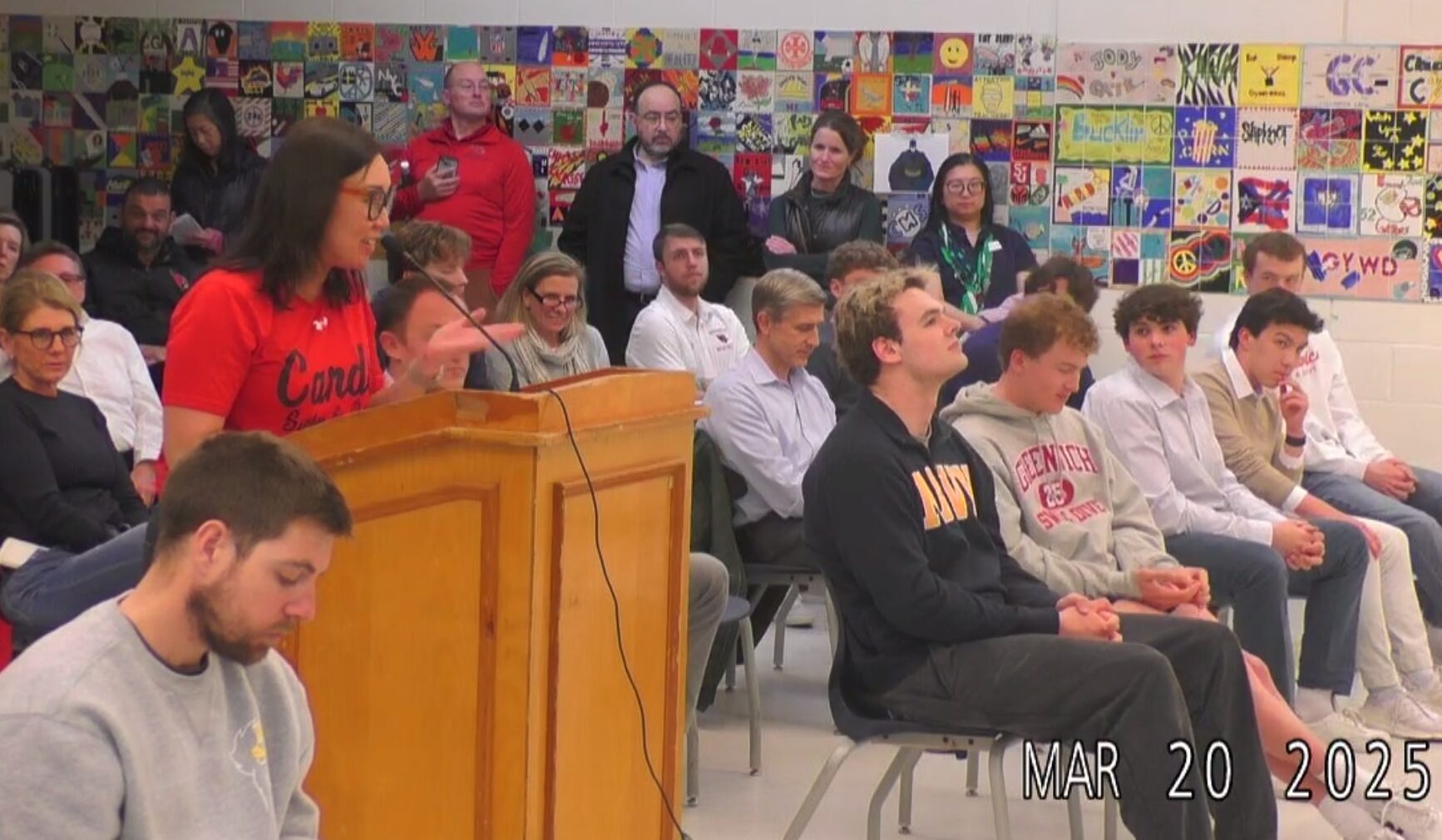During public comment at this week’s Board of Education meeting, swimmers and their families said they were shocked to learn about a consultant’s report and a potential 1-2 year shut down of the school’s eight-lane pool.
Constructed back in 1968 as part of the “new” high school on Hillside Road, the 25-yard swimming pool with its single 1-meter diving board have a host of issues.
Investigation was done after water appeared to be seeping out of the pool at the southeast corner. Water was ponding on new epoxy flooring and was considered a slip hazard as there is no drain in that location. In addition, an athlete’s hand was cut on a loose tile in the pool.

GHS boys swim team coach Terry Lowe spoke during the public hearing of the March 20, 2035 BOE meeting.
While the pool was drained to repair loose tiles it was discovered that the drains at the bottom of the pool did not comply with current code. The district staff installed a stop button for the pumps.
The district’s Facilities Dept worked with pool maintenance vendor, Connecticut Aquatics, and TLBA Architecture LLC to evaluate the pool.
 TLBA’s report said the pool’s main drain system is non-compliant with CT Dept of Public Health regulations and the Virginia Graeme Baker Pool & Spa Safety Act, a federal law named after a young girl who drowned after she was trapped under water by the powerful suction from a hot tub drain.
TLBA’s report said the pool’s main drain system is non-compliant with CT Dept of Public Health regulations and the Virginia Graeme Baker Pool & Spa Safety Act, a federal law named after a young girl who drowned after she was trapped under water by the powerful suction from a hot tub drain.
TLBA said the main drains have little to no water flow, creating a potential
suction entrapment risk, and the addition of an emergency shutoff switch neither eliminated the non-compliance, nor guaranteed swimmer safety.
There are also issues with diving clearances. The report said the pool’s diving area is compromised by building and structural elements that violate state building code clearances.

Clearance over the diving board is reduced by means of a steel girder, steel beams, sprinkler piping and ductwork. Circled in the photo is a water bottle placed on the flange of the girder by a diver. Also visible in the photo are names that were written on the beam (obscured so as to not identify students). The TLBA report said this could only have been accomplished by hanging from the beam long enough to write the name.
According to TLBA, there are major obstructions within the required overhead clearance for the diving board, including a steel girder, about 4-feet lower and 10-feet closer than allowed. Also encroaching into the clearance is the roof beam and deck structure, sprinkler piping and ductwork.
The report says all of these elements are reachable from the diving board, as evidenced by a water bottle placed on the flange, and names written on the beam, which would require a diver to actually hang from the beam to write their name.
“It should also be noted that when the board needs to be replaced, no manufacturer will sell a board to a facility with a non-compliant diving area. The diving board has been secured in an upright position, eliminating the safety issue,” TLBA said in their report.
Pool Deck and Other Equipment
The report said the pool deck is too narrow and and spectators share deck space with swimmers, violating health code regulations.
The filtration system is near the end of its lifespan and requires full replacement. Backwash discharge is improperly routed to a nearby brook instead of the sanitary sewer, violating environmental regulations. Electrical panels in the pool equipment room are not rated for corrosive environments, creating a code violation.
The consultants said that overall, the conditions are potential liability issues, and keeping the pool open potentially endangers users and violates safety regulations.
Their recommendation was to close the pool until the required safety and compliance upgrades are completed
The proposed timeline is 4-8 months for engineering & funding, followed by 1-2 years of construction & renovations.
Afterward, full operations would resume with a fully compliant and safe facility.

Public Comment
During public comment, GHS sophomore Connor McMahon, a varsity swimmer at GHS who is also a swimmer on the YWCA Dolphins club team said a two-year closure of the pool would be “disastrous” for all of the aquatics teams in town.
“Our swim team practices six days a week in that pool during the season, which begins in early December and runs until the end of March,” he said. “With over 40 athletes on the boys swim and dive teams, pool time is already hard to come by, and is staggered between the JV and varsity, as well as the dive team. ”
“It is one of the few competition pools in Fairfield County, and we host the majority of the swim meets for that reason,” he added. “I urge you to find a solution so that our teams will not face any interruptions during the critical fall, winter and spring aquatics seasons.”

Subscribe to the GFP daily newsletter.

Hadden Wood, a senior captain of the GHS swim team, said shutting down the pool for one to two years would be “catastrophic” to the aquatics teams.
“A long-term shut down would disrupt training and eliminate home meets and games including the Cardinal tournament for the boys public team and FCIACs for both the boys and girls swim teams.”
“On top of that, for athletes pursuing college recruitment, which is a relatively large portion of all the aquatics teams, losing a home facility would impact both their performance and exposure.”
Hadden said that a phased renovation plan that kept the pool operational would be preferable to a full shut down.

James Waters, who currently chairs the Old Greenwich School building committee, urged the BOE to establish a special committee to guide decision making. March 20, 2025
James Waters, who currently chairs the Old Greenwich School building committee, urged the BOE to establish a special committee to guide decision making.
“A credible group needs to go through this report in depth and recommend a course of action before school opens in this fall,” Waters said. “Having read this report in its entirely, the problems are clear and potentially major.”
“A focus group is critical. I will volunteer tonight for this effort, and I know many others will too,” he added. “Assuming we get this group in place now, we can get many questions answered before school opens this fall.”
Terry Lowe, who has coached the swim team at GHS for a whopping 57 years, and started the water polo program in 1975, coaching that team for 40 years, said coaches were taken by surprise by the report.
“I’ve literally spent decades of my life in the GHS pool. Unfortunately the report being presented to night was made without anyone speaking to me or any swimming, diving or water polo coach or teacher,” Lowe said. “After more than five decades of service I would like to think that my experience and expertise is some value in these discussions. Instead, historically projects are undertaken without consulting coaches, and mistakes have been made.”
Despite problems with the pool, coach Lowe said the pool was the envy of competing teams.
He said the diving area was “incredibly safe,” with deeper water than many pools in the state, and its high ceiling height met national high school federation rules.
He added that contrary to the statement in the report, the world’s number one manufacturer of diving boards sold the school a new diving board just two years ago – the diving area meeting their requirements.
Coach Lowe said only an Olympic diver treating the diving board like a trampoline could touch the beam pictured in the consultant’s report.
“We need to let divers know that that practice is banned,” he said. “Supervision of pools is both mandatory and necessary to keep swimmers and divers safe. This is true at even the newest and fanciest pools.”
“We can and must make sure that the pool equipment is used safely. The beam location is such that it will forever be yards away from any actual dive, even for the all-American divers that our team traditionally has.”
Lastly, coach Lowe said the pool was both functional and safe for swimming and diving use while a proposal is developed and construction executed, and that the school’s highly successful aquatics programs should not be interrupted.

Presentation materials, TLB Architecture, March 20, 2025. The GHS swimming pool was initially constructed in 1968 and had a major renovation in 1997. Main Drains covers were replaced in 2008, following the enactment of the Virginia Graeme Baker Pool and Spa Safety Act. No other major upgrades or renovations have been done since.
Parent Janet McMahon agreed there should be no interruption to the swim, dive and water polo seasons and urged that work be limited to the summers.
“I am also concerned that I am only now hearing about the apparent pool issues despite being an Education Committee delegate (on the RTM) for eight years, and PTA Council Facilities chairwoman for the past two years.
“I consider myself pretty well informed on town capital projects and issues, but was completely blind-sided by this especially given that the pool underwent some repairs this past summer,” she said.
“Why are the aquatics parents only now hearing about this and not in the fall of 2024 when the issues allegedly began?” McMahon asked.
“Why is this being considered an emergency even though these issues have existed since 1997 – almost 37 years ago, with no real injury or harm?”
Lastly, McMahon said she was unconvinced the situation was an emergency and that if it wasn’t possible to confine work to summers, a backup plan must be put forward for all impacted teams and clubs.

Janet McMahon said despite being an Education Committee delegate (on the RTM) for eight years, and PTA Council Facilities chairwoman for the past two years she was only just learning of the pool issues. March 20, 2025
Consultant’s Report
Mike Fortuna from TLBA who presented the report, said he was grateful for Zoom.
“I don’t think I’m the most popular guy in Greenwich right now,” he said.
“Even if you fix the sump you still have a piping problem. I would advise against fixing one thing without fixing the other. Because two years from now you could have a pipe failure. And then every dollar you spent fixing the drain sumps, you’re going to throw away because you’re going to dig up the pipe.”
As for the diving hopper, he said in the 1960s there was no building code or health code related to pools.
“It was compliant because there was no code,” he said. “In 1997, when the renovation happened, you were required to meet the state building code, which adopted the state health code, which adopted the NCAA standards for diving hoppers. So even though you are not an NCAA facility, the state health code adopted that as the standard.”
And though GHS has one of the deepest pools, but the pool still came up a bit short of code. However, he said the bigger challenge was overhead clearance.
He said the requirement was 16′-5″ from the tip of the board to the overhead clearance.
“You’ve g0t this giant steel beam a little over 12 ft high about six feet away. Can a diver hit it? I don’t know. Probably not, but the analysis I make is does it meet code? The answer is no.”
“Right now the diving board is hoisted so people can’t use it. Someone will have to make a decision what to do with diving. Raising the roof is a big job, but the only other alternative is to build another diving hopper somewhere else, on or off the property.”
Mr. Fortunata also talked about spectators coming in the winter with salt and mud on their shoes, and sharing the bleachers with the athletes.
“It’s a problem that should be addressed,” he said adding, “The heath code is clear about the absolute separation between spectators and swimmers.”
He also talked about the width of the deck, which is not a day-to day issue for swimmers to maneuver, but health code requires a 5 foot width.
“The issue is with somebody on a stretcher being tended to by a medic, the medic needs to walk alongside the stretcher.”
“There’s a lot of what-if’s and worst-case scenarios, but that’s what the codes are built around.”
He went on to talk about the failing filter plant and electrical gear.
And lastly, he warned about the pool filter backwash, which is basically chlorinated gray water that today goes into the storm system through a brook.
“The code requires that water to go to sanitary sewer,” he said likening the backwash to dishwasher or washing machine water with chlorine in it.
“Ideally that’s not going into a brook,” he said.
During Q&A with the BOE members Mr. Fortuna said that in the 1997 renovation when the school changed the volume of the swimming pool it was considered a major renovation, and the pool was then supposed to meet all the components of health code, which had adopted current NCAA regulations including the 16’5″ dive clearance requirement.
“That’s what should have been met in 1997,” he said.
“The 2008 and 2021 standards were the Virginia Graeme Baker federal law (applicable only to the drains), not state building code or state health code,” he added.
Fortuna said in his assessment, the 1997 renovation put the pool out of compliance.
BOE member Laura Kostin said the community’s biggest concern was the estimated timeline of 12-24 months.
“We’re building a school in 24 months, you can’t build a pool quicker than that?” Kostin asked.
Fortunata said 2 years was not an unreasonable time frame for a major capital project, and it was important to include time for the design phase and public input.
“You need to design it, bid it, and build – and from a municipal standpoint, you have rules you have to follow. If this were Yale University they could write a check tomorrow and start construction. You have a process you have to follow.”
Fortuna said a phased renovation of the existing facility with work limited to the summer months might extend over four or five years.
“You have to decide if you’re going to spend millions of dollars on a facility, do you really want to spend it on a pool that is 50 years old? Or does it make sense to build something new?”
BOE member Sophie Koven said the next step was a feasibility analysis about the useful life of the pool, whether it can be repaired, what repairs make sense and considering the legacy of the swimming, diving and water polo teams.
BOE Chair Karen Hirsh said another consideration was Floor Area Ratio (FAR) if the size increased or roof was raised.
The school is fully maxed out on FAR for its campus. A few years ago the P&Z director Katie DeLuca said GHS couldn’t even add a garden shed.
“I certainly would not want to see this pool shut down,” Hirsh said.
BOE member Kathleen Stowe said, “The pool is 50 years old. Perhaps we should have though of this earlier.”
Superintendent Dr. Toni Jones said having a feasibility study committee was the normal pathway for school projects.
“The committee would meet with coaches, swimmers, find out what is and is not working and look at all technical aspects with experts,” Jones said. “We could get this started really quickly and get going with feasibility.”
“We didn’t come here tonight saying we are going to close the pool,” Jones said. “Since I’ve been here in 6 years, we’ve Cardinal Stadium condemned, CMS was condemned, North Mianus School’s ceiling fell and we had to move kids for the rest of the school year. We just got kids back on the fields at Western middle School. None of those were BOE decisions. At any time you can have someone at the state who changes their position and their opinion about what we can and can’t do, we have risk management involved,” she said.
“There are a lot of people who weigh in on these decisions. I want to be cautious that it’s not always our decision. And the first four I dealt with were not our decision.”
The BOE agreed on a Sense of the Meeting Resolution to move forward with a feasibility committee and keep the pool open in the meantime.
The vote was unanimous 7-0. Wendy Vizzo Walsh was absent.

File photo: Leslie Yager